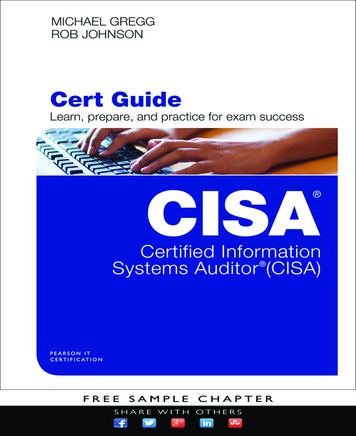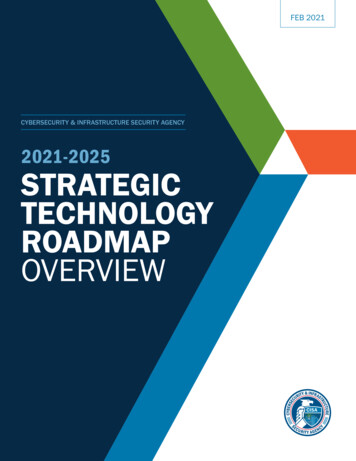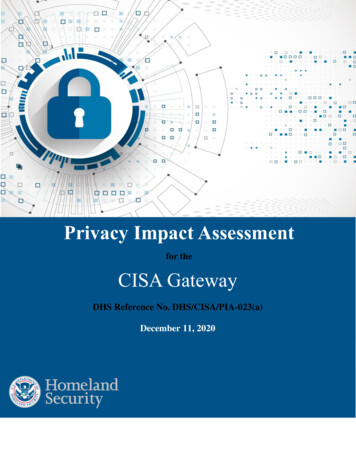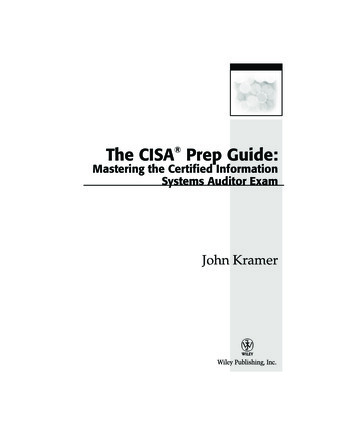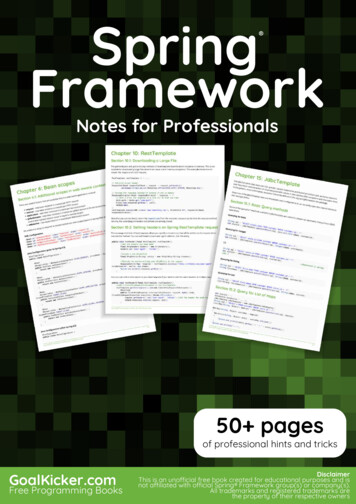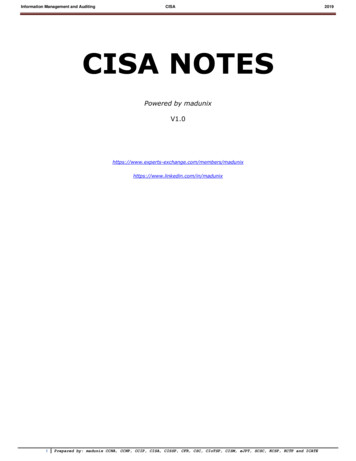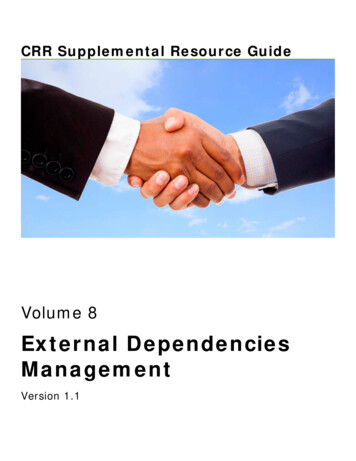
Transcription
CRR Supplemental Resource GuideVolume 8External DependenciesManagementVersion 1.1
Copyright 2016 Carnegie Mellon UniversityThis material is based upon work funded and supported by Department of Homeland Security under ContractNo. FA8721-05-C-0003 with Carnegie Mellon University for the operation of the Software EngineeringInstitute, a federally funded research and development center sponsored by the United States Department ofDefense.Any opinions, findings and conclusions or recommendations expressed in this material are those of theauthor(s) and do not necessarily reflect the views of Department of Homeland Security or the United StatesDepartment of Defense.NO WARRANTY. THIS CARNEGIE MELLON UNIVERSITY AND SOFTWARE ENGINEERINGINSTITUTE MATERIAL IS FURNISHED ON AN “AS-IS” BASIS. CARNEGIE MELLON UNIVERSITYMAKES NO WARRANTIES OF ANY KIND, EITHER EXPRESSED OR IMPLIED, AS TO ANYMATTER INCLUDING, BUT NOT LIMITED TO, WARRANTY OF FITNESS FOR PURPOSE ORMERCHANTABILITY, EXCLUSIVITY, OR RESULTS OBTAINED FROM USE OF THE MATERIAL.CARNEGIE MELLON UNIVERSITY DOES NOT MAKE ANY WARRANTY OF ANY KIND WITHRESPECT TO FREEDOM FROM PATENT, TRADEMARK, OR COPYRIGHT INFRINGEMENT.[Distribution Statement A] This material has been approved for public release and unlimited distribution.Please see Copyright notice for non-US Government use and distribution.CERT and OCTAVE are registered marks of Carnegie Mellon University.DM-0003283Distribution Statement A: Approved for Public Release; Distribution is Unlimited
Table of ContentsI. Introduction . 1Series Welcome .1Audience .3II. External Dependencies Management . 4Overview .4Summary of Steps .7III. Plan for External Dependencies Management. 9Before You Begin .9Step 1. Establish external dependencies support and strategy. . 10Step 2. Plan the relationship formation process. 12Step 3. Plan a process for identifying and prioritizing external dependencies. . 14Step 4. Plan for relationship management. . 16Step 5. Plan an information management process. . 18Output of Section III . 20IV. Implement the External Dependencies Management Plan . 21Before You Begin . 21Step 1. Assign responsibility for implementing the plan. . 22Step 2. Establish and maintain implementation measurements. 23Step 3. Formalize relationships with external entities. . 24Step 4. Identify and prioritize dependencies. . 26Step 5. Maintain requirements. . 28Step 6. Manage ongoing relationships. . 29Output of Section IV . 33V. Monitor and Improve External Dependencies Management . 34Before You Begin . 34Step 1. Define effectiveness measures. 34Step 2. Detect, analyze, and correct process exceptions. . 35Step 3. Report and review the program with stakeholders. 36Step 4. Improve the EDM program, plans, and procedures. . 36Output of Section VI . 37VI. Conclusion . 38Appendix A. Example External Dependencies Management Policy Template . 40Appendix B. External Dependencies Management Resources . 41Relationship and Cyber Information Resources. 41Other Resources . 42Appendix C. CRR/CERT-RMM Practice/NIST CSF Subcategory Reference . 45Endnotes . 47Distribution Statement A: Approved for Public Release; Distribution is Unlimited
I. IntroductionSeries WelcomeWelcome to the CRR Resource Guide series. This document is 1 of 10 resource guides developed by theDepartment of Homeland Security’s (DHS) Cyber Security Evaluation Program (CSEP) to help organizationsimplement practices identified as considerations for improvement during a Cyber Resilience Review (CRR). 1The CRR is an interview-based assessment that captures an understanding and qualitative measurement of anorganization’s operational resilience, specific to IT operations. Operational resilience is the organization’sability to adapt to risk that affects its core operational capacities. 2 It also highlights the organization’s ability tomanage external dependencies risk to critical services and associated assets during normal operations andduring times of operational stress and crisis. The guides were developed for organizations that haveparticipated in a CRR, but any organization interested in implementing or maturing operational resiliencecapabilities for critical services will find these guides useful.The 10 domains covered by the CRR Resource Guide series are1. Asset Management2. Controls Management3. Configuration and Change Management4. Vulnerability Management5. Incident Management6. Service Continuity Management7. Risk Management8. External Dependencies Management This guide9. Training and Awareness10. Situational AwarenessThe objective of the CRR is to allow organizations to measure the performance of fundamental cybersecuritypractices. DHS introduced the CRR in 2011. In 2014 DHS launched the Critical Infrastructure CyberCommunity or C³ (pronounced “C Cubed”) Voluntary Program to assist the enhancement of criticalinfrastructure cybersecurity and to encourage the adoption of the National Institute of Standards andTechnology’s (NIST) Cybersecurity Framework (CSF). The NIST CSF provides a common taxonomy andmechanism for organizations to1. describe their current cybersecurity posture2. describe their target state for cybersecurity3. identify and prioritize opportunities for improvement within the context of a continuous and repeatableprocess4. assess progress toward the target state5. communicate among internal and external stakeholders about cybersecurity risk1Distribution Statement A: Approved for Public Release; Distribution is Unlimited
The CRR Self-Assessment Package includes a correlation of the practices measured in the CRR to criteria ofthe NIST CSF. An organization can use the output of the CRR to approximate its conformance with the NISTCSF. It is important to note that the CRR and NIST CSF are based on different catalogs of practice. As aresult, an organization’s fulfillment of CRR practices and capabilities may fall short of, or exceed,corresponding practices and capabilities in the NIST CSF.Each resource guide in this series has the same basic structure, but each can be used independently. Each guidefocuses on the development of plans and artifacts that support the implementation and execution of operationalresilience capabilities. Organizations using more than one resource guide will be able to leveragecomplementary materials and suggestions to optimize their adoption approach. For example, this ExternalDependencies Management guide describes the creation and documentation of a list of critical suppliers, whichcan also be used to inform planning activities described in the Service Continuity Management guide. Otherexamples include planning asset management to include assets owned or controlled by external entities scoping situational awareness activities to include threats to external entities that the organization relies on identifying training and awareness activities that focus on external dependencies identifying incident management roles and responsibilities that pertain to external entitiesEach guide is based on best practices described in a number of sources, but primarily from the CERT Resilience Management Model (CERT -RMM). 3 The CERT-RMM is a maturity model for managing andimproving operational resilience, developed by the CERT Division of Carnegie Mellon University’s SoftwareEngineering Institute (SEI). The model is meant to guide the implementation and management of operational resilience activities converge key operational resilience management activities define maturity through capability levels enable maturity measurement against the model improve an organization’s confidence in its response to operational stress and crisisThe CERT-RMM provides the framework from which the CRR is derived—in other words, the CRR methodbases its goals and practices on the CERT-RMM process areas. See Appendix C for a cross reference betweenthe CRR and this guide.This guide is intended for organizations seeking help in establishing an external dependencies managementprocess or for organizations seeking to improve their existing external dependencies management process.More specifically this guide educates and informs readers about the external dependencies management process promotes a common understanding of the need for an external dependencies management process identifies and describes key practices for external dependencies management provides examples and guidance to organizations wishing to implement these practicesThe guide is structured as follows:I.Introduction—Introduces the CRR Resource Guide series and describes the content and structure ofthese documents.II. External Dependencies Management—Presents an overview of the external dependenciesmanagement process for IT-dependent organizations and establishes some basic terminology. CERT is a registered mark owned by Carnegie Mellon University.Distribution Statement A: Approved for Public Release; Distribution is Unlimited2
III. Plan for External Dependencies Management—Outlines a strategy and plan creation process andidentifies issues and considerations to help ensure that the plan addresses the organization’s externaldependencies management needs.IV. Implement the External Dependencies Management Plan—Outlines the process for ensuring that theorganization’s external dependencies management plan is implemented and meets the standards set bythe organization.V. Monitor and Improve External Dependencies Management—Outlines the process and considerationsfor improving and strengthening the external dependencies management process.VI. Conclusion—Provides a summary of key external dependencies management concepts and referencesfor further information.AppendicesA. Example External Dependencies Management Policy TemplateB. Relationship and Cyber Information ResourcesC. External Dependencies Management ResourcesD. CRR/CERT-RMM Practice/NIST CSF Subcategory ReferenceAudienceThe principal audience for this guide includes individuals responsible for managing external dependencies orsupply chain activities that affect IT operations. Executives who establish policies and priorities for externaldependencies management, managers and planners who are responsible for converting executive decisions intoaction plans, and operations staff who implement those external dependencies management plans may alsobenefit from this guide.To learn more about the source documents for this guide and for other information of interest, see Appendix B.3Distribution Statement A: Approved for Public Release; Distribution is Unlimited
II. External Dependencies ManagementOverviewIn today’s technology and business environment, organizations often rely on outside entities, includingtechnology vendors, suppliers of raw materials, shared public infrastructure, and other public services thatsupport the organization. External dependencies management (EDM) focuses on establishing an appropriatelevel of controls to manage the risks that originate from or are related to the organization’s dependence onthese external entities. The purpose of EDM is to ensure the protection and sustainment of services and assetsthat are dependent on the actions of external entities.This guide is intended to help organizations with the lifecycle of EDM, including planning the activity,forming new relationships with external entities, managing existing relationships, and monitoring andimproving the activity to refine the organization’s approach. The guide is intended for organizations wishing tocreate an EDM capability or improve their existing capability. The sections of the guide itself are structuredaccordingly into planning, implementing, and improving.Figure 1: External Dependencies, Assets, and Organizational MissionExternal dependencies and supply chain concerns are not new. Recently, however, advances in informationand communications technology (ICT) have made it possible for businesses to realize great efficiency gains,cost savings, and flexibility. At the same time, global competitive pressures have driven organizations to takeadvantage of these gains through automation and outsourcing. These trends have sometimes outpacedorganizations’ ability to manage the resulting risks, making it a growing priority to establish and manageappropriate controls to ensure the delivery of critical services dependent on the actions of external entities.Additionally, events such as the attacks of September 11, 2001, and the 2011 tsunami in Japan havedramatically demonstrated the extensive and potentially cascading impacts of major shocks to interconnectedsupply chains around the world. Outsourcing to external entities may provide certain advantages, but it mayintroduce uncertainty concerning the operational resilience of the organization and its core services. AnDistribution Statement A: Approved for Public Release; Distribution is Unlimited4
organization must make management of this uncertainty one of the key considerations when establishing howit manages its broader operational risk posture.The risk introduced by external dependency is one of the more challenging areas to manage becauseorganizations have a limited ability to directly monitor and control the vulnerabilities and threats introduced.Ensuring that external entities are meeting the risk objectives of an organization, across the full range ofresiliency management capabilities, is a broad scope to address. Moreover, managing the overallorganization’s operational risk profile when both the management and status of key external dependencies isuncertain is a challenge that has become one of the top priorities for organizations, governments, andregulators.External dependencies management includes activities commonly referred to by terms such as supply chain riskmanagement, vendor management, or critical infrastructure risk management.External dependencies exist when an entity that is external to the organization has access to, control of, ownership in,possession of, responsibility for, or other defined obligations related to one or more assets or services of the organization.Operational resilience is an organization’s ability to adapt to risk that affects its core operational capabilities. 4Like any organization, the external entities that the organization depends on may be susceptible to a diverseand dynamic array of threats, which can negatively affect the dependent organization’s people, information,technology, and facility assets and consequently the organization’s ability to meet its objectives (Figure 2). Thekey challenge for many organizations is their limited ability to ensure the resilience of the external entities theyrely on.Figure 2: Disruption—Loss of the Technology Supplier“Threat is a natural or man-made occurrence, individual, entity, or action that has or indicates the potential to harm life,information, operations, the environment, and/or property.” DHS Risk Lexicon, 2010 Edition 5Identifying, prioritizing, and managing relationships with external entities over their entire lifecycle arefoundational activities for the development of effective risk mitigation and disposition strategies. Thisdocument provides guidance for the management of external dependencies across this lifecycle. To effectivelymanage external dependencies, organizations should establish a strategy and basic plan for EDM key processes for identifying, prioritizing, monitoring, and tracking external dependencies guidance and procedures on the formation of relationships with external entities an approach for managing and governing existing external entity relationships ongoing oversight, reporting, and correction of external entity performance an approach for improving the organization’s EDM processes and program5Distribution Statement A: Approved for Public Release; Distribution is Unlimited
Like many key resilience practices, EDM should be thought of as a planned, continuous process. In the case ofEDM in particular, many organizations may have only ad hoc or incomplete processes around forming newrelationships with external entities or around managing existing relationships. It is also not unusual forparticular organizations to have detailed procedures around the formation of new relationships, but for theongoing management of relationships to run according to a substantially different set of objectives orstandards. Effective EDM requires standard, planned guidance across the entire lifecycle of external entityrelationships and continuous monitoring and improvement of the approach.Figure 3 captures the primary phases of the EDM process.Plan for d shipsFigure 3: The External Dependencies Management ProcessPlan for External Dependencies ManagementHaving a plan to drive EDM will increase the organization’s confidence in its ability to control dependencyrisk. Whether an organization is implementing a new program or improving existing processes, a plan can helpensure success and effectiveness. Plans should be documented, widely distributed, and regularly updated toensure they remain current and reflect any refinements that are identified.Developing an EDM plan is an enterprise-wide challenge, requiring extensive input and support. Thereforeestablishing manager and stakeholder support is a key component of planning EDM. Components of the planinclude how the organization will identify and prioritize dependencies, processes for forming new relationshipswith external entities, and the management of ongoing or existing relationships.Implement the External Dependencies Management PlanEstablishing strong, productive relationships with external entities from the start requires early, clear definitionof relationship requirements and expectations. This foundation can help build mutual trust betweenorganizations, promoting the open exchange of information, innovation, and efficiency.Distribution Statement A: Approved for Public Release; Distribution is Unlimited6
Creating and following clear, formal, and codified agreements with suppliers helps the organization manage itsresilience over the life of the relationships but it also helps the suppliers understand the organization’srequirements. Documented requirements form a valuable baseline of information that can be used to governcontracted relationships and to manage risks associated with relationships where the organization has limitedcontrol, such as shared infrastructure and public services suppliers.External suppliers or entities supporting organizations fall into three general relationship categories:Vendor—Entities are chosen by the organization and are typically governed by negotiated agreements. Examples includeproviders of raw materials, labor, consulting, maintenance, hardware/software, and facilities.Shared infrastructure—The supplier provides its services to a region or group. Agreements are usually standardized andare virtually the same across the customer base. Examples include power, water, and telecommunications.Public—Typically these relationships are with a government entity such as a state, local, or federal agency and are notgoverned by a contract or agreement. Examples include security services (fire, police) and transportation networks.Monitoring, governing, and correcting supplier performance are essential activities. As with all aspects ofdependency management the approach must be risk-based, reflecting the supplier’s importance and thepotential impact of its failure to meet the organization’s requirements. When appropriate, the organization maytake corrective actions such as imposing fines, transitioning to another vendor, or bringing the activity backinto the organization. The organization might also mitigate risk through other means, such as adding suppliersor strengthening its service continuity and incident management plans.Monitor and Improve External Dependencies ManagementMonitoring and improving the EDM processes and program help ensure that they continue to support theorganization’s objectives. This phase of the process focuses on maintaining the effectiveness of dependencyand risk management, and involves assessing the effectiveness of EDM and any needed refinements to theplan.Summary of StepsThe following sections of this guide describe the steps for planning, implementing, and monitoring andimproving EDM as described above:Plan for External Dependencies Management1.2.3.4.5.Establish external dependencies support and strategy.Plan the relationship formation process.Plan a process for identifying and prioritizing external dependencies.Plan relationship management.Plan an information management process.Implement the External Dependencies Management Plan1.2.3.4.5.6.7Assign responsibility for implementing the plan.Establish and maintain implementation measurements.Formalize relationships with external entities.Identify and prioritize dependencies.Maintain requirements.Manage ongoing relationships.Distribution Statement A: Approved for Public Release; Distribution is Unlimited
Monitor and Improve External Dependencies Management1.2.3.4.Define effectiveness measures.Detect, analyze, and correct process exceptions.Report and review the program with stakeholders.Improve the EDM program, plans, and procedures.Distribution Statement A: Approved for Public Release; Distribution is Unlimited8
III. Plan for External Dependencies ManagementBefore You BeginThe following checklist summarizes the tasks you will need to complete and the information you will need togather before you can begin developing an EDM plan.InputGuidanceLists of stakeholdersThe list of stakeholders should include all appropriate entities, both internal andexternal. Potential candidates include service/business owners within the organization business partners and vendors operations risk and/or other key organizational risk groups technology and infrastructure owners in the organization technology vendors public and shared services supplier leaders contract management service continuity information security regulators and auditors in-house counsel customers and providers who may be impacted in the event of serviceinterruption Guidance from seniorleadership andstakeholders on risktolerance, resiliencerequirements, andprogram objectives Assignment ofresponsibility fordeveloping the EDMplan Explicit assignment to a manager or set of managers in the organization fordeveloping the planBudget for EDMplanning Identification of available funds and resources to plan EDM:o staffing resourceso tools (applications and associated hardware)o third-party supporto technology to support resilience requirementso training and communicationLinkages to other EDMactivities and plans Coordination of other organizational activities around managing contracts, servicelevel agreements (SLAs), public and shared services supplier interaction, publicoutreach, or any other organizational activities that should be harmonized withEDMCommunication to risk stakeholders (i.e., audit, compliance, business partners,regulators) to gather support, expertise, and engagement 9 Preliminary/basic guidance on selection and requirements for contracted externalentitiesKey compliance and enterprise requirementsThe business objectives on which EDM activities should focusDistribution Statement A: Approved for Public Release; Distribution is Unlimited
External entities supporting the organization’s key services become, in some respects, an extension of theorganization itself. A strategy codified into a plan for EDM can provide managers with a higher degree ofconfidence that the organization uses consistent and appropriate standards and processes to form and sustainrelationships with the right entities.This section is intended to provide guidance for managers and leaders writing the EDM plan. The planprovides the framework and guidance for how the organization will approach and structure key EDMprocesses such as identifying and prioritizing dependencies, forming and managing relationships, and reliablymanaging all of the information associated with EDM. In almost any field of management or leadership, thereare always nuances or considerations that are important to successfully implementing a plan. Some necessaryprocedures or refinements are sometimes too detailed for inclusion in a higher level plan. These kinds ofconsiderations are discussed in Section IV, on implementation of the plan.Note that this guide assumes that an external dependency is being formed or already exists. It does not directlyaddress the broader question of how to decide whether or not to rely on an external entity for a business-criticalservice. In some cases, the external entity may have greater competence or capability in a particular area,which would ultimately lower the organization’s risk exposure. However, the organization may have lessflexibility to modify or tailor services provided by an outside entity than it would if it had fulfilled thatfunction internally. Hidden long-term costs downstream, such as staff time and other vendor monitoringexpenses, can also outweigh the benefits of outsourcing. In more serious cases, these costs may include failuressuch as breaches, outages, or fraud. The organization should consider, especially for its most essential services,all of these possible risks and cost implications and mitigate them through rigorous management andmonitoring.Step 1. Establish external dependencies support and strategy.Broad management support, participation, and adequate resource commitment are essential to the developmentof effective EDM. Managers developing an EDM strategy should obtain support and commitment fromexecutives and leaders f
The CERT-RMM provides the framework from which the CRR is derived—in other words, the CRR method bases its goals and practices on the CERT-RMM process areas. See . Appendix C for a cross reference between the CRR and this guide. This guide is intended for organizations seeking help i n establishing an external dependencies management
